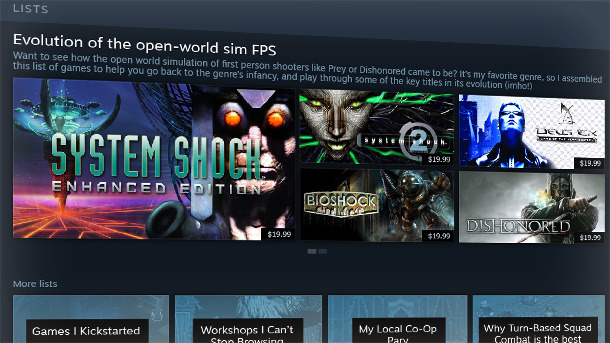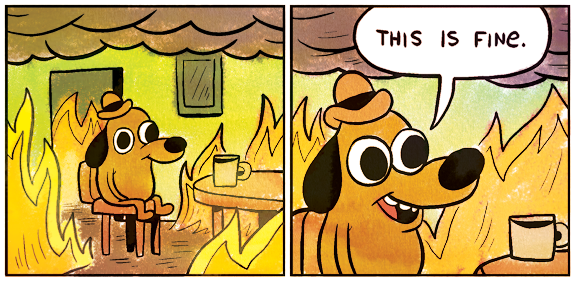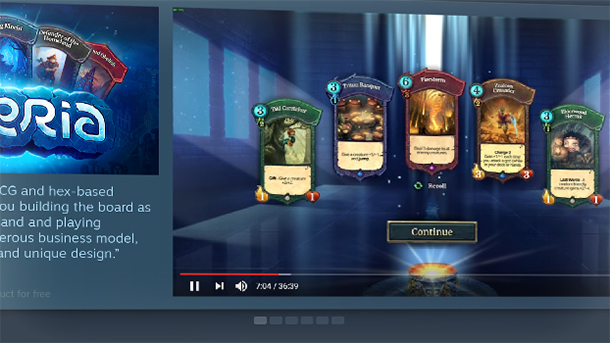Steam Direct Fee & Upcoming Store Updates
In this post we want to talk about Steam Direct's publishing fee, and some additional changes we're making to improve the way the Store works. If you haven't read
our first post, where we talked about the Steam Store algorithm, it's probably worth your time to nip back and read that first. That should help you better understand the reasoning behind the changes we're going to talk about in this post.
As you read, it's worth keeping in mind that there has been a subtle, but important shift in the way the Steam Store is designed. In the past, the challenge was to figure out what products should be on the Store. Now, we think the challenge is to figure out what products a specific player wants to see. There are many different kinds of players, with many different interests, so flexibility in how they view the Store seems like a requirement.
Determining the Steam Direct Fee
Back when we announced Steam Direct in February, we hadn't decided how much developers would need to pay to publish their games. We knew that we wanted it to be as small as possible to ensure it wasn't a barrier to beginning game developers, while also not being so small as to invite easy abuse by people looking to exploit our systems. We thought it would be great if the game community at large had a conversation about it, including both players and developers, which was why we chose not to highlight a specific amount in that original post.
Since then, we've seen a bunch of great conversations discussing the various pros and cons of whether there should be an amount, what that amount should be, ways that recouping could work, which developers would be helped or hurt, predictions for how the store would be affected, and many other facets to the decision. There were rational & convincing arguments made for both ends of the $100-$5000 spectrum we mentioned. Our internal thinking beforehand had us hovering around the $500 mark, but the community conversation really challenged us to justify why the fee wasn't as low as possible, and to think about what we could do to make a low fee work.
So in the end, we've decided we're going to aim for the lowest barrier to developers as possible, with a $100 recoupable publishing fee per game, while at the same time work on features designed to help the Store algorithm become better at helping you sift through games. We're going to look for specific places where human eyes can be injected into the Store algorithm, to ensure that it is working as intended, and to ensure it doesn't miss something interesting. We're also going to closely monitor the kinds of game submissions we're receiving, so that we're ready to implement more features like the the Trading Card changes we covered in the
last blog post, which aim to reduce the financial incentives for bad actors to game the store algorithm.
We believe that if we inject human thinking into the Store algorithm, while at the same time increasing the transparency of its output, we'll have created a public process that will incrementally drive the Store to better serve everyone using it.
Upcoming Updates to Steam Curators
We know that some players really want to see a human involved in the selection of products they see in the Steam Store. Prior to the Discovery update, that human was someone at Valve. As Steam grew, so did the types of players using it, and the range of games they wanted to see. Over time, we became less and less confident that we represented the interests of all those different players.
The Steam Curators features was designed to be a solution to this problem, allowing anyone to contribute to the process of highlighting games on Steam, and then allowing players to find someone who they felt represented their gaming interests. Some players feared that we'd give too much power to curators to control the Steam store, and that their own particular interests wouldn't be represented. So, as with the other filtering features in the Store, we chose to keep Curators strictly an opt-in feature, where the input from each curator only affected the Store algorithm for players who explicitly stated they wished to follow that curator.
Unfortunately, while we shipped the Curator feature in the first Discovery update, it hasn't received the attention it needs to be a good solution. So recently we've spent some time talking and listening to members of both sides - the curators using the system to provide commentary on the Store, and the players using the system to inform their decisions. In both areas we've identified a set of work that we believe will make it more useful.
We're expanding the kinds of content that Curators can create, allowing them to provide more information to players who are thinking about buying a game, and improving the tools to allow them to easily manage all their recommendations. We'll have some more details as we get closer to releasing the update, but here are some highlights:
Many Curators create content for other platforms, such as YouTube, so we're making it much easier for them to show that content alongside their curations.
One suggestion from Curators that we liked was the ability for them to create personal lists of games. This will allow Curators to provide specific kinds of advice, whether that's general suggestions about which games to buy in the current sale, or more specific lists, like which games to play to follow the evolution of a particular type of game design, the body of a work from a favorite developer, or the games in a Curator's weekly Game Club.

Another big request came from both Curators and developers, who want an easier way to help Curators get pre-release access to upcoming games. It's often hard for Curators to get the attention of developers who build the specific kinds of games that a Curator covers, and it can be similarly hard for a smaller developer to find the Curators who would be interested. So we're building a system that will make that a painless process for everyone involved, which means that you should see more useful curations coming out of the Curators who like to explore newer titles.
At the same time, we're making it easier for players to use Curators to help them browse the Store. Since they're an opt-in feature, we've decided to give Curators more visibility throughout the Store as a whole, so if you're following a Curator, you'll see their thoughts in new places, and with higher prominence.
Next Steps For Steam Direct
Like all the work in the Steam Store, Steam Direct will take some iteration to get the kinks out. We're optimistic. Aiming for the low publishing fee gives every game developer a chance to get their game in front of players. The Store algorithm will do its best to make sure you see games that are worth your time to look at. Combining everyone's increased visibility into the algorithm's thinking with the human eyes of Curators will hopefully ensure that whenever that algorithm isn't working properly, we'll know about it, and have the chance to fix it.
Our next post will wrap up this series of posts, where we'll cover the sunsetting of Greenlight, and the timing for the release of Steam Direct.















![The Year of Incline [2014] Codex 2014](/forums/smiles/campaign_tags/campaign_incline2014.png)























